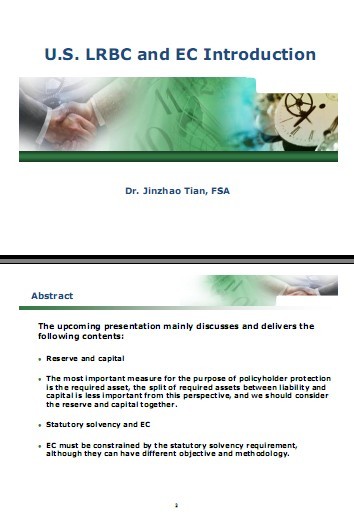U.S.LRBC and EC Introduction(53页)PPT.pdf
已下载:0 次 是否免费: 否 上传时间:2012-03-24

Abstract
The upcoming presentation mainly discusses and delivers the
following contents:
l Reserve and capital
l The most important measure for the purpose of policyholder protection
is the required asset, the split of required assets between liability and
capital is less important from this perspective, and we should consider
the reserve and capital together.
l Statutory solvency and EC
l EC must be constrained by the statutory solvency requirement,
although they can have different objective and methodology.
Table of Contents
Part1. U.S. LRBC Introduction
Part3. EC Practice in U.S. and Runoff Approach
Part2. Comparison: U.S. LRBC, E.U. Solvency II
History of Reserves and Capital (U.S.)
Reserve Valuation - Historical
n 1858 Massachusetts Legislation
n Net Level Premium Reserve Method and Combined Experience
(1843 British) Mortality Table and 4% Interest Rate
n Minimum reserve is based on a formula with prescribed
mortality and interest
n No actuarial judgment allowed in determining the minimum
n In 1990s, Asset Adequacy Analysis added to test the
adequacy of the formulaic reserve in light of the supporting
assets
History of Reserves and Capital (U.S.)
Risk-Based Capital (RBC) - Historical
n NAIC RBC regime is primarily formula-driven, derived from data
in published statutory statements, developed in the early 1990’s
n Calculation delineates four categories of risk (C1-C4):
n Calculation emphasizes solvency and the identification of weakly
capitalized companies

 立即下载
立即下载 立即收藏
立即收藏